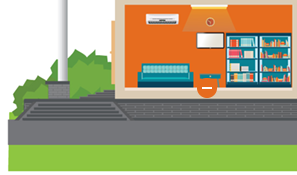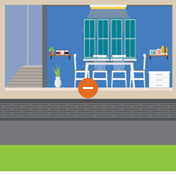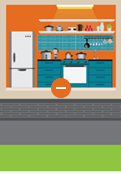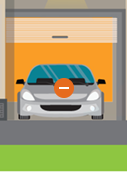Attic, Garage and Unconditioned Spaces
There are many unconditioned spaces in your home – attic, garage, utility room, etc. – which often get overlooked for energy-efficient and conservation measures. Let’s see what we can dig up!
Office and Electronics
In this digital age, electronics are found in every room of the house and many of them have energy-efficient settings. Check out our list below for more information.
Bedroom
Even while you sleep, your home can still use energy. Below we have outlined some tips on saving electricity and staying comfortable without breaking the bank.
Bathroom
This may not be a hot spot for energy efficiency, but there are ways to conserve energy without sacrificing comfort. Check those out below.
Living Room
From lighting to windows to your thermostat, the living room is a great place to make the most out of home energy savings. Read on to see how to reduce electricity bills in your main living space.
Miscellaneous
There are many more ways you can save energy that don’t necessarily fit into one particular room. We have you covered with more tips below.
Kitchen
Even with energy-efficient appliances, you can still learn how to save money on electric bills with the helpful tips you’ll find below.
HVAC – Heating, Ventilation and Air Conditioning
The majority of your energy usage comes from your HVAC system. Below we have outlined numerous tips to help you stay comfortable and maintain your system while lowering your utility bills.
Maintaining a healthy home environment
Energy efficiency isn’t the only thing to consider when maintaining your living space. Keeping moisture and air quality in mind also goes a long way toward a safe, healthy home. Check out our Introduction to Health and Safety video and explore helpful homeowner tips below.
MOISTURE
- Water infiltration can lead to building deterioration by biological pests. These pests also pose a threat to human respiratory health.
- Water corrodes metal, dissolves glue, warps wood and weakens mortar – making routine repair and replacement of certain areas of your home costly.
- Water can permanently damage your insulation’s thermal resistance (the ability to slow heat transfer). Depending on the temperature, this can also lead to mold.
Warm air rises and escapes through tiny leaks/gaps in your home insulation, causing subtle currents that transfer water vapor as well as temperature – especially when you’re running the HVAC.
- Winter air-leakage carries your moist indoor air through the home to the outdoors, leading to drier home air.
- Summer air-leakage brings the warm, moist outdoor air into your home, increasing home humidity.
INDOOR AIR QUALITY
Carbon monoxide, nitrogen oxides, volatile organic compounds (VOCs), and fine dust particles contribute to air pollution, even while you’re inside. By far the biggest source of harmful byproducts to home air are natural gas appliances and tobacco smoke.
- Dryers, fireplaces, stovetop ranges, furnaces, water heaters, automobiles and space heaters fueled by natural gas all release byproducts of combustion into your indoor air.
- Vented gas-fueled space heaters can release some byproduct gases during operation. This is called backdrafting.
- The byproducts in the smoke from wood stove combustion is particularly dangerous and contains high concentrations of numerous toxins.
- Carbon Monoxide (CO) is a by-product of incomplete combustion from a gas furnace. Since electric/resistance furnaces do not burn (combust) anything, there is no process of combustion.
- Higher concentrations of CO (50-3,000 ppm*) can lead to severe headaches, vomiting, and even death.
*parts per million - Lower concentrations of CO (5-50 ppm) may result in flu-like symptoms and often go undetected.
- The EPA suggested maximum indoor exposure to CO is 8 hours at 9 ppm.
- Malfunctioning combustion appliances (e.g. unvented combustion space heaters, leaky wood stoves or gas ranges, and backdrafting vented space heaters) can all contribute to elevated CO levels.
- Gas furnaces and boilers are also prone to backdrafting emissions and should be checked regularly.
- Flame interference can also release CO into the air. Dirt or debris buildup, misaligned burners, inadequate airflow – even resting a pan on a stovetop burner — could release carbon monoxide into your home.
- Cracked heat exchangers (on gas furnaces)
- Improperly installed or a poorly designed appliance venting (water heaters, gas furnaces, etc.)
- A depressurized zone near a furnace, water heater or room heater from exhaust fans, clothes dryer vents and chimneys can all depressurize this combustion zone.
- Nitrogen oxides are created naturally by the combustion of hydrocarbons in air.
- This means all combustion motor vehicles (i.e. cars, trucks, trains, etc.) produce nitrogen oxide.
- Nitrogen oxides cause impaired respiratory function in healthy adults at just 2 ppm.
- Combustion that produces visible smoke – such as wood stoves, unvented kerosene space heaters, cigarettes, even candles – release fine hydrocarbon dust and VOCs into the air.
- Other household sources of VOCs include: aerosol sprays, preservatives in wood, air fresheners, paints, strippers and other solvents.
- Building materials, varnishes, office equipment (copiers, printers), adhesives and permanent markers can also all release VOCs.
- Radon is a colorless, odorless and radioactive inert gas that occurs naturally.
- The Nebraska Department of Health and Human Services (DHHS) provides Nebraska residents information on radon test kits.
- Any home with a radon concentration above 4 pC/L (pico-Curies per liter of air) should be mitigated.
- Contact your local Heath Department or a professional radon consultant for radon testing, resources and mitigation.
- Visit the Environmental Protection Agency's website to learn more about radon.
MITIGATION (What to do)
- Carbon monoxide meters (available at most hardware stores) provide accurate CO measurements and may have other air-quality features depending on the model.
- Plug-in home detectors often come with battery backups and/or double as smoke detectors.
- Wireless detectors provide an option for whole-home testing at multiple potential sources of carbon monoxide.
- Modern air-quality monitors are portable, giving you the ability to measure CO, formaldehyde, VOCs and more in surrounding air anywhere. Some smart models provide data-tracking, wireless device control, instant notification, schedule routines and more!
- Ensure you have plenty of fresh, open air when using products that emit VOCs.
- Follow recommended safety guidelines and precautions when using VOC products.
- Never mix different VOC products together unless specifically directed by manufacturer instructions.
- Have a licensed, bonded HVAC contractor inspect your heating/cooling system at least twice a year; have them verify that your furnace’s high limit control is working properly.
- Install and maintain a carbon-monoxide detector near your heating/cooling system.
- Bathroom and kitchen exhaust fans pull air – and any chemicals that may be present in the air – up through the fan and out of the home. It is highly recommended to install an exhaust fan above the stove and use it whenever you are cooking.
- Have your heating/cooling system inspected by a licensed, bonded HVAC contractor to ensure the combustion safety in your home.
- A home energy audit helps identify potential issues around your house – with safety as well as efficiency. An audit provides a full performance report, including moisture problems, combustion hazards and other safety issues.
- To find a local energy rater, please visit:


















